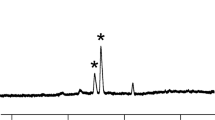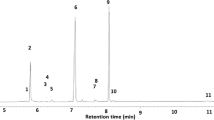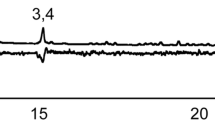Abstract
Males of the green capsid bug, Lygocoris pabulinus, exhibit a specific courtship behavior, i.e., a vibration of the abdomen. When both live and dead females were offered to males, this vibration behavior was elicited in most of the males tested. When females were dissected into separate body parts, heads, wings, and legs elicited equal responses, while thorax plus abdomen elicited a much lower response. When separate body parts were extracted, the leg extracts elicited significantly stronger responses than any other extract. This suggests that female L. pabulinuslegs are either the source of a close-range sex pheromone or that pheromone is accumulated on the legs due to grooming behavior. The leg extracts contained several hydrocarbons such as n-alkenes, n-alkanes, and some methylalkanes. Female extracts contained more (Z)-9-pentacosene and male extracts contained more (Z)-9-heptacosene. Substrates on which females had walked elicited similar responses as female legs, indicating that the pheromone is deposited on the substrate. This enlarges the functional range of low-volatility compounds, which are thought to function only when sexes are in close vicinity or in contact.
Similar content being viewed by others
REFERENCES
ALDRICH, J. R. 1988. Chemical ecology of the Heteroptera. Annu. Rev. Entomol. 33:211-238.
BAKER, J. E., NELSON, D. R., and FATLAND, C. L. 1979. Developmental changes in cuticular lipids of the black carpet beetle, Attagenus megatoma. Insect Biochem. 9:335-339.
BEANI, L., and CALLONI, C. 1991. Leg tegumental glands and male rubbing behavior at leks in Polistes dominilus(Hymenoptera: Vespidae). J. Insect Behav. 4:449-461.
BLOMMERS, L. H. M., VAAL, F. W. N. M., and HELSEN, H. H. M. 1997. Life history, seasonal adaptations, and monitoring of common green capsid Lygocoris pabulinus(L.) (Hemiptera: Miridae). J. Appl. Entomol. 121:389-398.
BLOMQUIST, G. J., TILLMAN-WALL, J. A., GUO, L., QUILICI, D. R., GU, P., and SCHAL, C. 1993. Hydrocarbon and hydrocarbon derived sex pheromones in insects: Biochemistry and endocrine regulation, pp. 317-351, inD. W. Stanley-Samuelson and D. R. Nelson (eds.). Insect Lipids: Chemistry, Biochemistry & Biology. University of Nebraska Press, Lincoln, Nebraska.
BOLTON, H. T., BUTLER, J. F., and CARLSON, D. A. 1980. Amating stimulant pheromone of the horn fly, Haematobia irritans(L.): demonstration of biological activity in separated cuticular components. J. Chem. Ecol.6:951-964.
BUTENANDT, A., BECKMANN, R., STAMM, D., and HECKER, E. 1959. Ñber den Sexuallockstof des Seidenspinner, Bombyx mori. Reindarstellung und Kostitution. Z. Naturforsch. 14B:283-284.
CARAYON, J. 1971. Notes et documents sur l'appareil odorant métathoraciques des Hémiptéres. Ann. Soc. Entomol. Fr.7:737-770.
CARDé, R. T., and MINKS, A. K. 1997. Insect Pheromone Research: New Directions. Chapman and Hall, New York, 684 pp.
CARDé, R. T., BAKER, T. C., and ROELOFS, W. L. 1975. Behavioral role of individual components of a multichemical attractant system in the Oriental fruit moth. Nature253:348-349.
CARLSON, D. A., MAYER, M. S., SILHACEK, D. L., JAMES, J. D., BEROZA, M., and BIERL, B. A. 1971. Sex attraction pheromone of the house fly: Isolation, identification and synthesis. Science174:76-77.
CARLSON, D. A., LANGLEY, P. A., and HUYTON, P. 1978. Sex pheromone of the tsetse fly: Isolation, identification, and synthesis of contact aphrodisiacs. Science201:750-753.
CARLSON, D. A., ROAN, C., YOST, R. A., and HECTOR, J. 1989. Dimethyl disulfide derivatives of long chain alkenes, alkadienes and alkatrienes for gas chromatography/mass spectrometry. Anal. Chem.61:1564-1571.
COLWELL, A. E., SHOREY, H. H., BAUMER, P., and VAN VORHIS KEY, S. E. 1978. Sex pheromone scent marking by females of Pectinophora gossypiella(Lepidoptera: Gelechiidae). J. Chem. Ecol.4:717-721.
CONNOR, W. E., EISNER, T., VANDER MEER, R. K., GUERRO, A., GHIRINGELLI, D., and MEINWALD, J. 1980. Sex attractant of an arctiid moth (Utetheisa orntrix): A pulse chemical signal. Behav. Ecol. Sociobiol. 7:35-63.
DILLWITH, J. W., BLOMQUIST, G. J., and NELSON, D. R. 1981. Biosynthesis of the hydrocarbon components of the sex pheromone of the housefly, Musca domesticaL. Insect Biochem. 11:247-253.
DOI, M., NEMOTO, T., NAKANISHI, H., KUWAHARA, Y., and OGUMA, Y. 1997. Behavioral response of males to major sex pheromone component, (Z,Z)-5,25-hentriacontadiene, of Drosophila ananassaefemales. J. Chem. Ecol.23:2067-2078.
DRIJFHOUT, F. P., VAN BEEK, T. A., VISSER, J. H., and DE GROOT, Æ. 2000. On-line thermal desorptiongas chromatography of intact living insects for pheromone analysis. J. Chem. Ecol.26:1383-1392.
FAUVERGUE, X., HOPPER, K. R., and ANTOLIN, M. F. 1995. Mate finding via a trail sex pheromone by a parasitoid wasp. Proc. Natl. Acad. Sci. U.S.A.92:900-904.
FUKAYA, M., YASUDA, T., WAKAMURA, S., and HONDA, H. 1996. Reproductive biology of the yellowspotted longicorn beetle, Psacotheca hilaris(Pascoe) (Coleoptera: Cerambycidae). III. Identification of contact sex pheromone on female body surface. J. Chem. Ecol.22:259-270.
GRAHAM, H. M. 1988. Sexual attraction of Lygus hesperusKnight. Southwest. Entomol. 13:31-37.
GROOT, A. T., VAN DER WAL, A. J., SCHUURMAN, A., VISSER, J. H., BLOMMERS, L. H. M., and VAN BEEK, T. A. 1998. Copulation behavior of Lygocoris pabulinusunder laboratory conditions. Entomol. Exp. Appl.88:219-228.
GU, X., QUILICI, D., JáAREZ, P., BLOMQUIST, G. J., and SCHAL, C. 1995. Biosynthesis of hydrocarbons and contact sex pheromone and their transport by lipophorin in females of the German cockroach (Blattella germanica). J. Insect Physiol.41:257-267.
HARDIE, J., and MINKS, A. K. (eds.). 1999. Pheromones of Non-Lepidopteran Insects Associated with Agricultural Plants. CABI Publishing, Oxon, UK, 466 pp.
HOWARD, R.W., and BLOMQUIST, G. J. 1982. Chemical ecology and biochemistry of insect hydrocarbons. Annu. Rev. Entomol. 27:149-172.
JACKSON, L. J. 1983. Cuticular hydrocarbons of the milkweed bug Oncopeltus fasciatusby age and sex. Insect Biochem. 13:19-25.
JUáREZ, P., and BLOMQUIST, G. J. 1993. Cuticular hydroacorbons of Triatoma infestansand T. mazzotti. Comp. Biochem. Physiol. 106B:667-674.
KAINOH, Y., and OISHI, Y. 1993. Source of sex pheromone of the egg-larval parasitoid Ascogaster reticulatusWatanabe (Hymenoptera: Braconidae). J. Chem. Ecol.19:963-969.
KENNEDY, J. S. 1977. Behaviorally discriminating assays of attractants and repellents, pp. 215-229, inH. H. Shorey and J. J. McKelvey, Jr. (eds.). Chemical Control of Insect Behavior, Theory and Application. John Wiley & Sons, New York.
LANG, J. T. 1977. Contact sex pheromone in the mosquito Culiseta inornata(Diptera: Culicidae). J. Med. Entomol.14:448-454.
LEADBETTER, G., and PLIMMER, J. R. 1979. An improved preparation of some insect sex attractants: Synthesis and separation of geometrical isomers by formation of urea complexes. J. Chem. Ecol.5:101-108.
MARSH, D. 1972. Sex pheromone in the aphid Megoura viciae. Nature238:31-32.
MCBRIEN, H. L., and MILLAR, J. C. 1999. Phytophagous bugs, pp. 277-304, inJ. Hardie and A.K. Minks (eds.). Pheromones of Non-Lepidopterous Insects Associated with Agricultural Plants. CABI Publishing, Oxon, UK.
MCCULLAGH, P., and NELDER, J. A. 1989. Generalized Linear Models, 2nd ed. Chapman and Hall, London.
MILLAR, J. G., and RICE, R. E. 1998. Sex pheromone of the plant bug Phytocoris californicusKnight (Heteroptera: Hemiptera: Miridae). J. Econ. Entomol.91:132-137.
MILLAR, J. G., RICE, R. E., and WANG, Q. 1997. Sex pheromone of the mirid bug Phytocoris relativusKnight. J. Chem. Ecol.23:1743-1754.
MINKS, A. K., and VAN DEVENTER, P. 1992. Practical applications: The European scene, pp. 9-18, inR. L. Ridgway, M. Inscoe, and H. Arn (eds.). Insect Pheromones and Other Behavior-Modifying Chemicals. BCPC Monograph No 51. Farnham, British Crop Protection Council.
MORGAN, E. D., HöLLDOBLER, B., VAISAR, T., and JACKSON, B. D. 1992. Contents of poison apparatus and their relation to trail-following in the ant Deceton atmigerum. J. Chem. Ecol.18:2161-2168.
MUHAMMED, S., BUTLER, J. F., and CARLSON, D. A. 1975. Stable fly sex attractant and mating pheromones found in female body hydrocarbons. J. Chem. Ecol.1:399-412.
PAULMIER, I., BAGNÈRES, A., AFONSO, C. M. M., DUSTICIER, G., RIVIÈRE, G., and CLÈMENT, J. 1999. Alkenes as a sexual pheromone in the leaf-cutter bee Megachile rotundata. J. Chem. Ecol.25:471-490.
PICKETT, J. A., WADHAMS, L. J., and WOODCOCK, C.M. 1992. The chemical ecology of aphids. Annu. Rev. Entomol.37:67-90.
SCHAL, C., SEVALA, V. L., YOUNG, H. P., and BACHMANN, J. A. S. 1998. Sites of synthesis and transport pathways of insect hydrocarbons: Cuticle and ovary as target tissues. Am. Zool. 38:382-393.
SCHIESTL, F. P., AYASSE, M., PAULUS, H. F., LöFSTEDT, C., HANSSON, B. S., IBARRA, F., and FRANCKE, W. 1999. Orchid pollination by sexual swindle. Nature399:421-422.
SCHIESTL, F. P., AYASSE, M., PAULUS, H. F., LöFSTEDT, C., HANSSON, B. S., IBARRA, F., and FRANCKE, W. 2000. Sex pheromone mimicry in the early spider orchid (Ophrys sphegodes): Patterns of hydrocarbons as the key mechanism for pollination by sexual deception. J. Comp. Physiol. A186:567-574.
SCHLEIN, Y., GALUN, R., and BEN-ELIAHU, M. N. 1980. The legs of Musca domesticaand Glossina morsitansfemales as the site of sex pheromone release. Experientia38:1174-1176.
SMITH, R. F., PIERCE, H. D., and BORDEN, J. H. 1991. Sex pheromone of the mullein bug, Campylomma verbasci(Meyer) (Heteroptera: Miridae). J. Chem. Ecol. 17:1437-1447.
STADDON, B. W. 1979. The scent glands of Heteroptera. Adv. Insect Physiol. 14:351-418.
UEBEL, E. C., SCHWARS, M., SONNET, P. E., MILLER, R. W., and MENZER, R. E. 1978. Evaluation of the mating stimulant pheromone of Fannia canicularis, F. pusio, and F. femoralisas attractants. Fla. Entomol. 61:139-143.
Author information
Authors and Affiliations
Rights and permissions
About this article
Cite this article
Drijfhout, F.P., Groot, A.T. Close-Range Attraction in Lygocoris pabulinus ∥L.). J Chem Ecol 27, 1133–1149 (2001). https://doi.org/10.1023/A:1010311928256
Issue Date:
DOI: https://doi.org/10.1023/A:1010311928256




